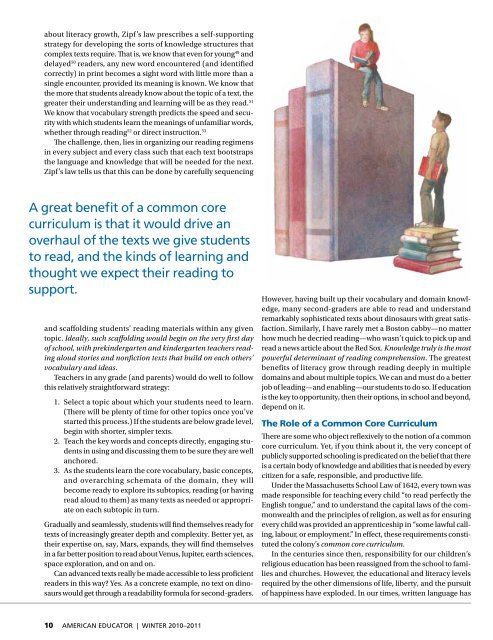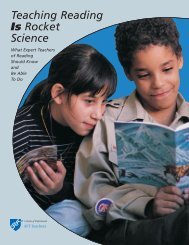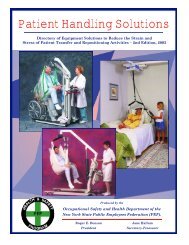American Educator, Winter 2010-11, Vol. 34, No. 4, AFT
American Educator, Winter 2010-11, Vol. 34, No. 4, AFT
American Educator, Winter 2010-11, Vol. 34, No. 4, AFT
You also want an ePaper? Increase the reach of your titles
YUMPU automatically turns print PDFs into web optimized ePapers that Google loves.
about literacy growth, Zipf’s law prescribes a self-supporting<br />
strategy for developing the sorts of knowledge structures that<br />
complex texts require. That is, we know that even for young 49 and<br />
delayed 50 readers, any new word encountered (and identified<br />
correctly) in print becomes a sight word with little more than a<br />
single encounter, provided its meaning is known. We know that<br />
the more that students already know about the topic of a text, the<br />
greater their understanding and learning will be as they read. 51<br />
We know that vocabulary strength predicts the speed and security<br />
with which students learn the meanings of unfamiliar words,<br />
whether through reading 52 or direct instruction. 53<br />
The challenge, then, lies in organizing our reading regimens<br />
in every subject and every class such that each text bootstraps<br />
the language and knowledge that will be needed for the next.<br />
Zipf’s law tells us that this can be done by carefully sequencing<br />
A great benefit of a common core<br />
curriculum is that it would drive an<br />
overhaul of the texts we give students<br />
to read, and the kinds of learning and<br />
thought we expect their reading to<br />
support.<br />
and scaffolding students’ reading materials within any given<br />
topic. Ideally, such scaffolding would begin on the very first day<br />
of school, with prekindergarten and kindergarten teachers reading<br />
aloud stories and nonfiction texts that build on each others’<br />
vocabulary and ideas.<br />
Teachers in any grade (and parents) would do well to follow<br />
this relatively straightforward strategy:<br />
1. Select a topic about which your students need to learn.<br />
(There will be plenty of time for other topics once you’ve<br />
started this process.) If the students are below grade level,<br />
begin with shorter, simpler texts.<br />
2. Teach the key words and concepts directly, engaging students<br />
in using and discussing them to be sure they are well<br />
anchored.<br />
3. As the students learn the core vocabulary, basic concepts,<br />
and overarching schemata of the domain, they will<br />
become ready to explore its subtopics, reading (or having<br />
read aloud to them) as many texts as needed or appropriate<br />
on each subtopic in turn.<br />
Gradually and seamlessly, students will find themselves ready for<br />
texts of increasingly greater depth and complexity. Better yet, as<br />
their expertise on, say, Mars, expands, they will find themselves<br />
in a far better position to read about Venus, Jupiter, earth sciences,<br />
space exploration, and on and on.<br />
Can advanced texts really be made accessible to less proficient<br />
readers in this way? Yes. As a concrete example, no text on dinosaurs<br />
would get through a readability formula for second-graders.<br />
10 AMERICAN EDUCATOR | WINTER <strong>2010</strong>–20<strong>11</strong><br />
However, having built up their vocabulary and domain knowledge,<br />
many second-graders are able to read and understand<br />
remarkably sophisticated texts about dinosaurs with great satisfaction.<br />
Similarly, I have rarely met a Boston cabby—no matter<br />
how much he decried reading—who wasn’t quick to pick up and<br />
read a news article about the Red Sox. Knowledge truly is the most<br />
powerful determinant of reading comprehension. The greatest<br />
benefits of literacy grow through reading deeply in multiple<br />
domains and about multiple topics. We can and must do a better<br />
job of leading—and enabling—our students to do so. If education<br />
is the key to opportunity, then their options, in school and beyond,<br />
depend on it.<br />
The Role of a Common Core Curriculum<br />
There are some who object reflexively to the notion of a common<br />
core curriculum. Yet, if you think about it, the very concept of<br />
publicly supported schooling is predicated on the belief that there<br />
is a certain body of knowledge and abilities that is needed by every<br />
citizen for a safe, responsible, and productive life.<br />
Under the Massachusetts School Law of 1642, every town was<br />
made responsible for teaching every child “to read perfectly the<br />
English tongue,” and to understand the capital laws of the commonwealth<br />
and the principles of religion, as well as for ensuring<br />
every child was provided an apprenticeship in “some lawful calling,<br />
labour, or employment.” In effect, these requirements constituted<br />
the colony’s common core curriculum.<br />
In the centuries since then, responsibility for our children’s<br />
religious education has been reassigned from the school to families<br />
and churches. However, the educational and literacy levels<br />
required by the other dimensions of life, liberty, and the pursuit<br />
of happiness have exploded. In our times, written language has





